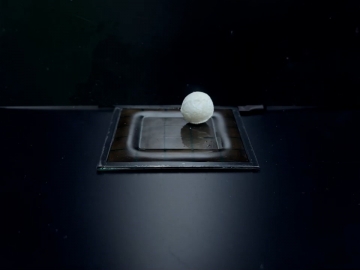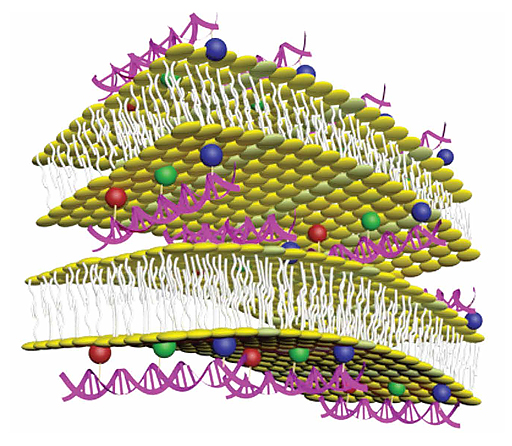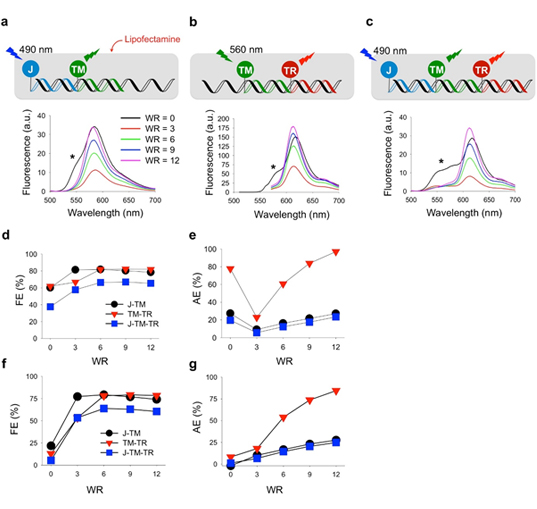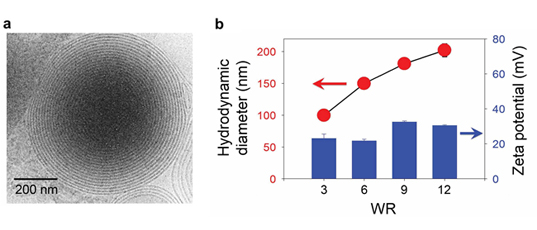KAIST
BREAKTHROUGHS
Research Webzine of the KAIST College of Engineering since 2014
Spring 2025 Vol. 24Onion-like DNA-lipid nanoparticles for light harvesting
A novel strategy is developed for constructing efficient and multiscale light harvesting antennae by incorporation of DNA-templated chromophores into a larger onion-like lipid structure that mimics the unique membrane structure of natural photosystems.
Article | Fall 2017
Natural light-harvesting complexes (LHCs), found in photosynthetic systems of cyanobacteria and plants, include chromophore arrays to absorb and transfer solar energy to the reaction center, where charge separation generates chemical potential for photosynthetic reactions. Chromophores are precisely aligned at nanoscale intervals for highly-efficient, directed, and long-range energy transfer, which is critical for the coherent excitation flux into the reaction center.
The exquisite structure of natural LHCs has motivated scientific communities to explore the supramolecular assembly of chromophores to construct artificial LHCs. DNA has gained considerable attention as an excellent one-dimensional building block for precise control of the distance between chromophores in the nanoscale and even the direction of energy transfer due to its high rigidity, regularity, and specific molecular recognition properties. However, the extension of DNA-templated chromophore arrays to larger-scale structures is required for the practical applications of the LHCs to photoelectric and photoelectrochemical systems. To achieve multiscale assembly of chromophores, mimicking natural photosystems that utilize a stack of multiple lipid bilayers found in natural photosystems can be an excellent solution.
Professor Yoon Sung Nam (Department of Materials Science and Engineering at KAIST) and his team recently suggested a simple method to construct a multiscale LHC structure through electrostatic complexation of DNA-templated chromophore arrays with cationic lipid nanostructures. Three different chromophores are covalently linked to the end of three different 10-nucleotide single-stranded DNA (ssDNA) fragments, respectively, and these ssDNA fragments are designed for hybridization with different locations of a 30-nucleotide matrix ssDNA to construct DNA-templated chromophore arrays. The hybridized chromophore duplexes were electrostatically self-assembled with cationic lipid nanostructures to form an onion-like DNA-lipid complex nanoparticle. The constructed nanoparticles showed a hydrodynamic diameter of up to 200 nm and was evaluated in terms of apparent energy transfer efficiency and overall antenna effect efficiency. The DNA-templated chromophore arrays themselves showed an energy transfer at only 4°C due to their low melting temperatures while the incorporation of DNA-templated chromophores into the nanoparticles dramatically increased both the efficiencies and antenna effects of the single- and two-step energy transfers at room temperature. These results show that placing the DNA-templated chromophores between the interstitial spaces of onion-like lipid structures enables structural stabilization, efficient energy transfer by reducing the relative permittivity of the surrounding medium, and larger-scale interstrand energy transfer.
The findings suggest that the supramolecular self-assembly of DNA-templated chromophores, which was investigated for energy transfer for the first time, can be a promising approach toward directed, long-range light harvesting. The principle and main results of this research can be found in an article entitled “DNA Lipoplex-Based Light-Harvesting Antennae” published on May 15th, 2017 in Advanced Functional Materials(http://dx.doi.org/10.1002/adfm.
201700212).
Most Popular

When and why do graph neural networks become powerful?
Read more
Extending the lifespan of next-generation lithium metal batteries with water
Read more
Smart Warnings: LLM-enabled personalized driver assistance
Read more
Professor Ki-Uk Kyung’s research team develops soft shape-morphing actuator capable of rapid 3D transformations
Read more
Oxynizer: Non-electric oxygen generator for developing countries
Read more


